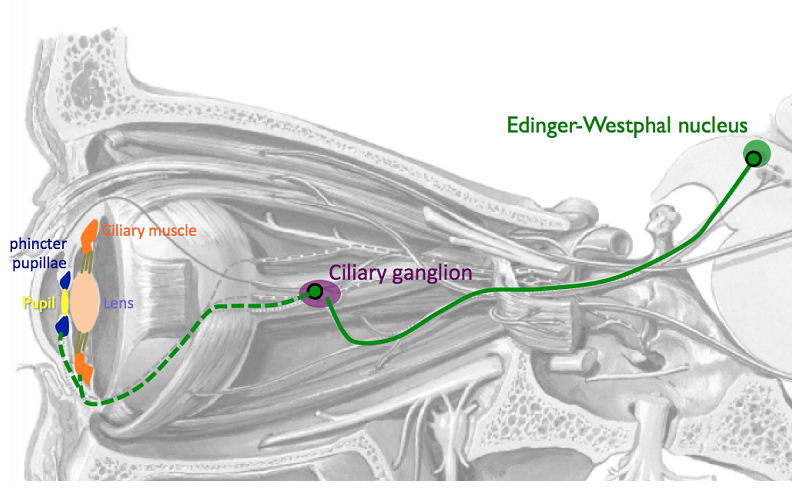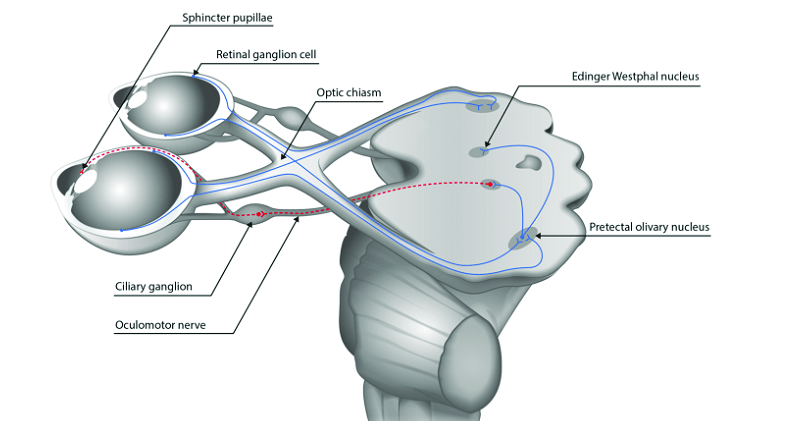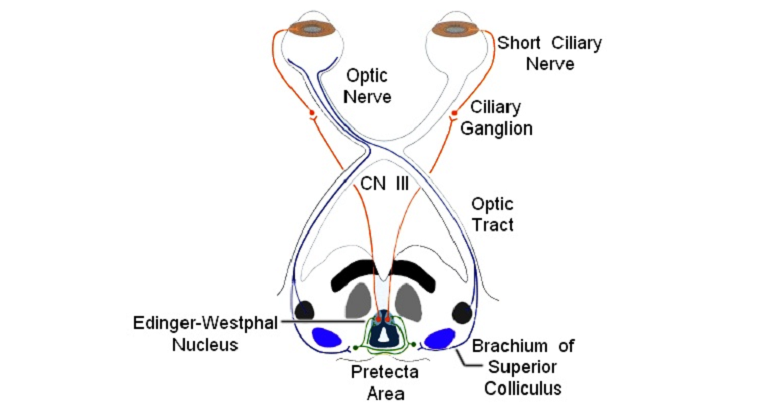
Nestled deep within the complex architecture of the human brain lies the Edinger-Westphal nucleus (EW), a component whose influence extends far beyond the simple mechanics of pupil reflexes. This tiny yet mighty structure plays a pivotal role in the intricate ballet of brain functions, orchestrating a range of activities from emotional regulation to stress response. Despite its modest size, the EW nucleus is a crucial nexus in the understanding of brain anatomy and neurophysiology.
Contents
- Introduction to the Edinger-Westphal Nucleus (EW)
- Anatomy of the Edinger-Westphal Nucleus
- Primary Functions of the EW Nucleus
- Beyond Pupil Reflexes: Diverse Roles of the EW Nucleus
- Disorders Associated with EW Nucleus Dysfunction
- References
Introduction to the Edinger-Westphal Nucleus (EW)
Exploring the depths of the human brain introduces us to various intricate structures, each playing a unique role in our complex neurological framework. Among these is the Edinger-Westphal nucleus (EW), a relatively small yet remarkably significant component. Traditionally recognized for its role in pupil reflexes, the EW nucleus’s functions extend far beyond this basic physiological response.
Overview of the Edinger-Westphal Nucleus (EW)
The Edinger-Westphal nucleus, often overshadowed by more prominent brain structures, deserves attention for its complex role in our nervous system. Primarily known for regulating the constriction of the pupil and lens accommodation in response to light, recent research has begun to unveil its involvement in a range of other critical functions. This exploration will provide a comprehensive look at the EW nucleus, from its anatomical characteristics to its surprising roles in various neural processes.
Importance of the Edinger-Westphal Nucleus in Brain Anatomy and Function
Understanding the Edinger-Westphal nucleus is essential for grasping the broader picture of brain function. While its primary association with the autonomic control of the eye is well documented, its influence extends to areas such as stress response, emotional regulation, and even neuroendocrine functions. By examining the EW nucleus, we gain insights into how even small neural structures can have significant impacts on our overall brain health and cognitive functioning.
Brief Historical Background of the Edinger-Westphal Nucleus
The discovery and study of the Edinger-Westphal nucleus have a rich historical background. Named after Ludwig Edinger and Charles Westphal, who first identified it in the late 19th century, this nucleus has been a subject of interest and research for over a century. Tracing the history of its discovery and subsequent studies not only honors the work of early neurologists but also illustrates the evolving understanding of brain anatomy through the ages.
Anatomy of the Edinger-Westphal Nucleus
The Edinger-Westphal nucleus, though small, holds significant importance in the realm of brain anatomy. Its intricate structure and connections with other parts of the brain underscore its multifaceted role in neural function.
Location and Structure of the Edinger-Westphal Nucleus
Located in the midbrain, adjacent to the oculomotor nucleus, the Edinger-Westphal nucleus is part of the central nervous system. It is bilaterally symmetrical, meaning it exists on both the left and right sides of the brain. This structure is characterized by a collection of neurons that are distinct in their neurochemical composition. The EW nucleus’s strategic position near the oculomotor nerve is crucial for its role in eye movements and pupil size regulation [1].
Connection of the Edinger-Westphal Nucleus to the Oculomotor Nerve
One of the most critical aspects of the EW nucleus is its connection to the oculomotor nerve (cranial nerve III). This nerve is responsible for controlling the majority of the eye’s movements. Neurons from the EW nucleus project axons that join the oculomotor nerve, influencing the parasympathetic innervation of the eye. This connection is essential for coordinating activities such as pupil constriction and lens accommodation, necessary for normal vision.
Neurochemical Composition of the Edinger-Westphal Nucleus
The neurochemical makeup of the Edinger-Westphal nucleus is another area of great interest. It contains a high concentration of neurons that produce specific neurotransmitters, including acetylcholine and various neuropeptides. These neurotransmitters are vital for transmitting signals from the brain to the eye, ensuring that the eyes respond appropriately to various stimuli. Understanding this neurochemical composition is crucial for comprehending how the EW nucleus influences both ocular and non-ocular functions.

Primary Functions of the EW Nucleus
The Edinger-Westphal nucleus (EW), while often associated with basic eye functions, plays a pivotal role in several key physiological processes. Here we explore the primary functions of the EW nucleus, revealing its crucial role in both the ocular and autonomic systems. By understanding these functions, we can appreciate the EW nucleus’s significance in maintaining everyday health and well-being.
Edinger-Westphal Nucleus Role in Pupil Reflexes
The most well-known function of the EW nucleus is its involvement in controlling pupil reflexes. This reflex is essential for protecting the retina from excessive light and for adjusting vision to varying light conditions.
Light Reflex Mechanism
The EW nucleus is integral to the light reflex mechanism. When light enters the eye, it triggers a signal that is relayed to the EW nucleus. In response, the nucleus sends signals to constrict the pupil, thereby regulating the amount of light that enters the retina. This reflex is crucial for preventing damage to the eye from excessive light and for optimizing vision under different lighting conditions [2].
Accommodation Reflex
Alongside the light reflex, the EW nucleus is also involved in the accommodation reflex, which adjusts the lens’s shape for focusing on near and distant objects. This process is vital for clear vision at varying distances, ensuring that the eye can quickly adapt to different visual environments.
Interaction of the Edinger-Westphal Nucleus with the Autonomic Nervous System
Beyond its role in ocular functions, the EW nucleus has a significant influence on the autonomic nervous system.
Parasympathetic Functions
The EW nucleus forms a part of the parasympathetic nervous system, which is responsible for the ‘rest and digest’ responses in the body. Its activity helps in reducing heart rate, dilating blood vessels, and promoting digestion, playing a key role in maintaining the body’s homeostasis.
Stress Response Modulation
The EW nucleus also contributes to modulating the body’s response to stress. It does this by influencing the parasympathetic activities that counteract the stress-induced ‘fight or flight’ response. This function is essential for maintaining balance in the body’s reaction to stressful stimuli, preventing overactivation of stress responses [3].

Beyond Pupil Reflexes: Diverse Roles of the EW Nucleus
While the Edinger-Westphal nucleus (EW) is primarily known for its role in controlling pupil reflexes, recent research has uncovered a plethora of additional functions that it performs, highlighting its versatility and importance in the broader context of neurological function.
Edinger-Westphal Nucleus Role in Stress Response and Emotional Regulation
One of the less known but critically important functions of the EW nucleus is its involvement in the body’s stress response and emotional regulation.
Modulating Stress Response
The EW nucleus plays a significant role in modulating the body’s reaction to stress. It helps balance the autonomic nervous system by supporting the parasympathetic response, often referred to as the ‘rest and digest’ state. This modulation is crucial in preventing the overactivation of the sympathetic nervous system, which is responsible for the ‘fight or flight’ response.
Influencing Emotional Regulation
Besides its physical role in stress management, the EW nucleus also has an impact on emotional regulation. Its connections with other brain areas, including those involved in processing emotions, allow it to influence our emotional responses, contributing to a more balanced emotional state.
Edinger-Westphal Nucleus Implications in Neuroendocrine Functions
The EW nucleus also has significant implications in neuroendocrine functions, affecting various hormonal processes within the body.
Regulating Hormone Release
It plays a role in the regulation of certain hormones, particularly those related to stress and relaxation. This regulation is essential for maintaining homeostasis and ensuring the body’s proper response to different internal and external stimuli.
Impact on Physiological Processes
Through its influence on hormone release, the EW nucleus affects several physiological processes. These include, but are not limited to, digestion, metabolism, and even immune system response, highlighting its role in overall health and well-being [4].
Impact of the Edinger-Westphal Nucleus on Circadian Rhythms
Lastly, the EW nucleus is involved in regulating circadian rhythms, which are the physical, mental, and behavioral changes that follow a 24-hour cycle.
Influencing Sleep-Wake Cycles
The EW nucleus helps regulate the sleep-wake cycle, influencing the timing of sleep, wakefulness, and various physiological processes that are tied to this cycle.
Adapting to Environmental Changes
Its role in circadian rhythm regulation is also crucial for adapting to environmental changes, such as light exposure and seasonal shifts, ensuring that the body’s internal clock remains synchronized with the external world.
Disorders Associated with EW Nucleus Dysfunction
The significance of the Edinger-Westphal nucleus (EW) extends into the realm of clinical neurology, where its dysfunction is linked to various disorders. Understanding these associations is crucial for both diagnosis and treatment. In this section, we explore the range of disorders that can arise from EW nucleus dysfunction, highlighting the importance of this structure in maintaining neurological health.
Common Symptoms and Manifestations of Edinger-Westphal Nucleus Disorders
Disorders resulting from EW nucleus dysfunction can manifest in several ways, given its involvement in diverse physiological processes.
Ocular Symptoms
Given its primary role in controlling pupil reflexes, dysfunction in the EW nucleus often leads to ocular symptoms. These can include abnormalities in pupil size and reaction, as well as difficulties in accommodating vision to different light intensities and distances.
Autonomic Symptoms
Since the EW nucleus is part of the autonomic nervous system, its dysfunction can disrupt various autonomic functions. This disruption can manifest as irregularities in heart rate, blood pressure, and digestive processes [5].
Edinger-Westphal Nucleus Link to Specific Neurological Disorders
The dysfunction of the EW nucleus has been linked to several specific neurological disorders, further emphasizing its importance in neurology.
Neuro-Ophthalmological Disorders
Conditions affecting the eyes and vision, such as Adie’s pupil and certain forms of strabismus, can arise from EW nucleus abnormalities. These disorders often result in impaired pupil responses and coordination issues in eye movement.
Neurodegenerative Diseases
There is emerging evidence that the EW nucleus may be involved in certain neurodegenerative diseases. For example, abnormalities in the EW nucleus have been observed in conditions like Parkinson’s disease and Alzheimer’s disease, suggesting a potential link between this nucleus and broader neurological dysfunction.
Potential for Misdiagnosis of Edinger-Westphal Nucleus Conditions
Given the diverse range of symptoms and the relatively obscure nature of the EW nucleus, there is a potential for misdiagnosis.
Challenges in Diagnosis
The overlapping symptoms with other neurological conditions can make it challenging to accurately diagnose EW nucleus dysfunction. This difficulty is compounded by the limited awareness of the nucleus’s role in these disorders.
Importance of Accurate Diagnosis
Accurate diagnosis is crucial for effective treatment. Misdiagnosis can lead to ineffective or even harmful treatments, emphasizing the need for heightened awareness and improved diagnostic methods for conditions related to the EW nucleus.
References
[1] Neuroanatomy, Edinger–Westphal Nucleus (Accessory Oculomotor Nucleus)
[2] Edinger-Westphal nucleus
[3] Characterization of genetic differences within the centrally projecting Edinger–Westphal nucleus
[4] Edinger-Westphal Nucleus
[5] Involvement of Centrally Projecting Edinger–Westphal Nucleus Neuropeptides

